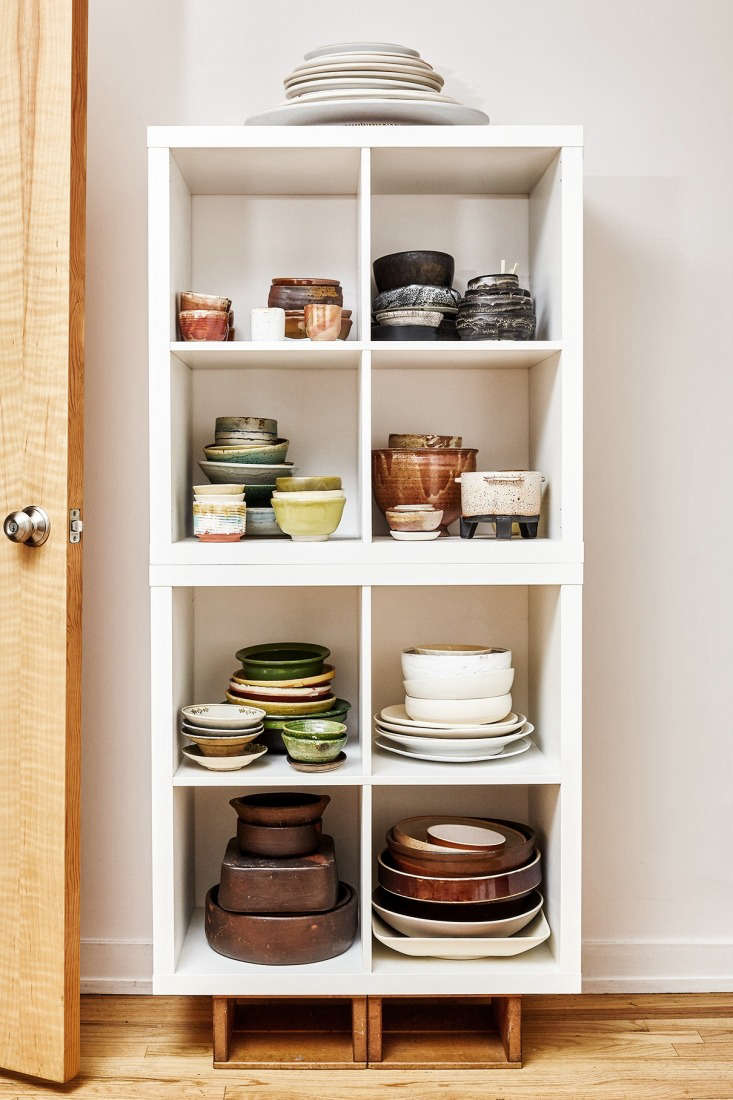
Of course we love a good tricked-out, state-of-the-art kitchen built from scratch, but there’s something about less-than-ideal older kitchens retrofitted with creative, budget-minded storage solutions that tickles us. Chef David Tanis’s kitchen in the East Village falls into this latter category—it has few built-in cabinets and practically no counter space—and it’s a perfect example of how simple ingenuity can transform a quirky configuration into a hardworking space. Here are seven storage takeaways from his kitchen.
N.B.: To learn more about the author of David Tanis Market Cooking and his kitchen, see Chef David Tanis’s Low-Tech, Economical, and Beautifully Soulful Kitchen in the East Village.
Photography and styling for Remodelista by Heidi’s Bridge.
1. Elevate low-cost finds.
It’s not surprising that Ikea shows up in this kitchen. We all know the store has great values. What is surprising is how Tanis upgrades the mass-market pieces. Here’s our favorite hack from his kitchen.

2. Move furniture into the kitchen.
An easy solution to little-t0-no cabinets in the kitchen: Move in storage furniture that’s usually meant for dining and living rooms—think hutches, buffets, sideboards, and the like.



3. Put wheels on it.
Tanis and his partner’s apartment is composed of just two 20-by-20-foot rooms. When they have guests over, they can quickly reconfigure the kitchen thanks to a rolling kitchen island. “Casual dinner in the kitchen is on stools, maximum four people,” he says. “The island is on wheels and easy to move, which is great for opening up the space when needed.”


4. Use storage as display.
If you walk into any commercial kitchen, you’ll notice that nearly everything a cook needs—pots, pans, utensils, knives—are stored out in the open, either hanging from walls, resting on open shelves, or corralled into containers on counters. Tanis’s personal kitchen is no different.

5. Go low-tech.
Small appliances and high-tech gadgets are oftentimes the main culprits when it comes to kitchen clutter. Tanis doesn’t have to make room for them simply because he doesn’t own very many. “I’m really a mortar and pestle person—you saw my collection. I avoid using electric appliances, if at all possible. An electric spice mill can be handy, though, and a blender is useful. Why anyone would use a garlic press is baffling,” he says.


6. Create stations.
Life is easier when you have everything you need in reach. Tanis stores his tools out in the open, grouping like with like: He has a knife station, a cooking utensils area, and a spot just for his cutting boards. Having dedicated stations makes both cooking and cleaning up a breeze.

7. Find creative solutions.
This is what gives a kitchen soul, we believe: finding creative solutions to your storage needs.


More clever kitchen storage lessons ahead:
- Outside the Box: 7 Unexpected Open Storage Strategies for the Kitchen
- Tricks of the Trade: 7 Small-Space Storage Tips from Emil Eve Architects
- 9 Unexpected Storage Hacks from a Food Photographer’s Kitchen
N.B.: This post is an update; it was first published June 2020.






Have a Question or Comment About This Post?